
Artichokes
in Alaska:
Gardening outside the box
By Marion Owen, Fearless
Weeder for PlanTea, Inc. and
Co-author of Chicken Soup for the Gardener's Soul
FEATURE ARTICLE:

Tom Hanks' "Power of Four" solution
More good stuff:
Who is Marion Owen?
FAQs about PlanTea
Search Marion's articles, tips and recipes
Why grow organic?
News and press releases
Read love letters
How to link to this site
Need a speaker?
How to contact Marion
Visiting Alaska?
Come to Kodiak Island!
Go to home page

Marion's UpBeet Gardener
Newsletter has been
replaced by Marion's blog
which you can find at:
www.marionowen.wordpress.com
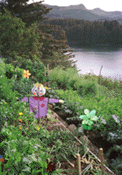 When people hear about subsistence living in Alaska, usually it's fishing,
hunting, and trapping that comes to mind. Because of Alaska's extreme
climate however, gardening rarely enters the formula of living off the
land.
When people hear about subsistence living in Alaska, usually it's fishing,
hunting, and trapping that comes to mind. Because of Alaska's extreme
climate however, gardening rarely enters the formula of living off the
land.
I thought so too, until I visited Midge and Bruce Short's hillside garden on Anton Larsen Island, a small island in the Kodiak Island archipelago, located 45 minutes (by jet) south of Anchorage, Alaska.
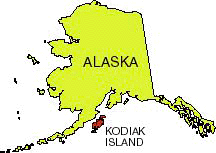
My husband Marty and I arrived in our inflatable raft on a sunny Sunday afternoon in early September. The leaves were already turning and fall was in the air. Midge and Bruce greeted us on their beach. "Come on up," said Midge. "I can't stay away too long, though. I'm canning fava beans and I have to watch the canner."
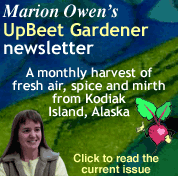 Bruce led the way up steep, flat-rock steps to the garden, which opened
up into an impressive collection of raised beds, covered gardens, a greenhouse,
and various stands of raspberries, beans, and young fruit trees. From
the beach, you'd never know such 'horticultural happenings' existed behind
the alders and spruce trees.
Bruce led the way up steep, flat-rock steps to the garden, which opened
up into an impressive collection of raised beds, covered gardens, a greenhouse,
and various stands of raspberries, beans, and young fruit trees. From
the beach, you'd never know such 'horticultural happenings' existed behind
the alders and spruce trees.
I'd heard rumors of locally-grown artichokes, so I glanced around for hints of their existence. As one of my all-time favorite vegetables, I'd dreamed of someday being able to grow artichokes in Kodiak. But I was stuck on the belief that the exotic thistles only grew in Monterey, California, not in northern latitudes. A few minutes later, Midge arrived, satisfied that the pressure canner would behave itself for a while.
"Since we began gardening with the idea of subsisting on what we grew, our Safeway bills have gone way down," said Midge proudly, in her soft English accent. "We had to really look at what we ate. For example, how many carrots and onions would we need in a year? Not many people consider that these days. We never had, either."
Bruce and Marty took off to inspect the wind generator, leaving Midge and I to talk plants. As we walked along the paths between beds of kale, Brussels sprouts, peas, and asparagus--yes, asparagus--Midge explained how their tastes changed. "We've learned to grow and appreciate crops that thrive here, such as celeriac and many different kinds of greens. We also learned you can grow a lot more than potatoes, turnips, and rutabagas."
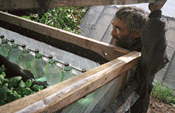
They concentrated on learning each plant's needs by researching and experimenting with compost, mulch, and soil-warming techniques. Ribbon kelp, hauled up on the tram from the beach, covers many of the beds and acts like a slow-release fertilizer. Crushed shells are turned into the soil for minerals and micro-nutrients and fed to the chickens for the same benefits.
But growing food was only half of the subsistence gardening formula. As Midge and Bruce perfected their techniques, they were rewarded with abundant harvests.
"We were so caught up in the growing, we didn't think about storage," Midge explained. "As things ripened and needed picking, we frantically dug holes and packed produce into buckets which we'd set in the ground to keep them cool."
Finally, they couldn't put off the inevitable any longer. One day, Midge grabbed a couple tools and walked around the hill behind the garden. After she found the right spot, she started carving away at the embankment. She dug and dug until a root cellar took shape. Bruce followed with timbers, walls, a ceiling, an entrance, and storage shelves.
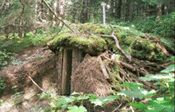
Midge capped the Hobbit-like cellar with a mesh of spruce boughs and a thick mattress of moss wrapped in fish net. The finishing touch was a path of crushed shells leading to the entrance. Though the root cellar was empty and airing out when I saw it, I could imagine onions hanging from the ceiling and shelves filled with potatoes, carrots, cabbage, celery. . . and oh, those wonderful rich, earthy smells.
Another learning curve had to do with dispelling classic, preconceived notions about Alaska gardening that many people carry with them from 'Outside' or the Lower 48, as it's often called.
"We had dreams of growing beans, tomatoes, and squash out in the garden, uncovered, like you see in garden magazines," Midge said, brushing her bouncy, dark curls away from her eyes. Kodiak's weather--though tempered by the warm Japanese current and not nearly as harsh as the minus 60-degree conditions in the Alaska's interior--had lessons of its own.
"We soon learned that each summer was different with wind, rain, overcast and cool; then lots of sun and then fog."
Bruce and Midge also had to contend with pests like slugs, aphids, and voles. You won't find chemical fertilizers or pesticides in their garden. Rather, they choose to use preventive measures to keep damage to a minimum. Slugs are picked on a regular basis, especially on cloudy days. For voles however, which can mow down a bed of lettuce overnight, they adopted a stronger tactic.
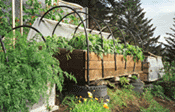
critters, slugs and other pests.
Many of their raised beds are literally raised up--built on top of short stacks of rubber tires. By not being in direct contact with the ground, voles are unable to scamper up into the beds. Slugs, it turns out, are too lazy to make the climb.
Bruce and Midge hope to someday share their experiences and knowledge by inviting apprentices to live, learn, and work with them for a period of time.
Toward the end of our visit, Midge led me through the giant raspberry patch, down a path, and toward a clearing in the trees. There, in full sun and standing taller than my 5-foot, 3-inch frame were dozens of artichoke plants. And every one of them was topped with full-sized artichokes. I couldn't have been happier than at that moment.
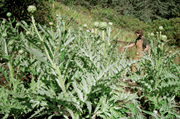
Back on the beach, we hugged goodbye and vowed to continue sharing gardening tips, trials, and tribulations. In my backpack, Midge's gift of two softball-sized artichokes made me smile. I thought of a comment she made, almost as an aside, while explaining the process of determining how produce they'd need in a year, taking into account variables like voles, weather, untimely frosts, and one another important factor.
"We always allow a margin for gift-giving," she said.

Thanks for visiting and please stop by again. I'll put the coffee on!
Meet Marion Owen /// Learn about PlanTea /// Online Catalog /// Articles, Tips, Recipes /// Get free UpBeet Gardener newsletter /// Read current issue /// Listen to radio show /// Read news and press releases /// More resources and links /// Learn why 'grow organic?' /// View guidelines for retailers /// Read love letters /// Book Marion as a speaker /// Site map /// How to link to us /// Contact us /// Go to home page
PlanTea: The organic plant food in tea bags. http://www.plantea.com
Copyright ©1996 to present: PlanTea, Inc. All Rights Reserved. PO Box 1980, Kodiak, AK 99615-1980 USA
Questions or comments? marion@plantea.com Phone: Toll Free: 1-800-253-6331 (US and Canada); 907-486-2500